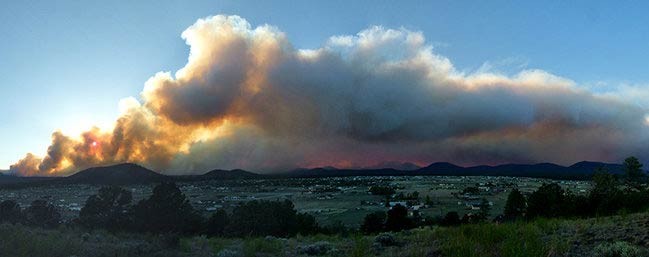Expected to be fully contained today, the Schultz Fire that scorched more than 15,000 acres in northeast Flagstaff and captured worldwide attention is human caused in more ways than one, said Northern Arizona University experts.
“This is a human caused fire from two perspectives,” said Daniel Laughlin, a research associate with the university’s Ecological Restoration Institute. “A human campfire was left to burn in an ecosystem that became dense because of 100 years of mismanagement.”
A century of fire suppression has successfully kept fire off the peaks—a landscape dominated by ponderosa pine, which typically burn every two to 45 years. The blaze torched an area not burned since the 1890s in an ecosystem historically subject to frequent, low intensity fires.
Pete Fulé, forestry professor and managing director of the institute, said the lack of fire has dramatically altered the composition and structure of the forest, while management of the area had grown complex because of high public visibility and community connection to the San Francisco Peaks.
His research has found that forests on the peaks are denser, with more fire-intolerant species and less structural diversity that allows the surface fires, which naturally occur in the ecosystem, to become full blown wildfires.
Tree density alone increased from 60 to 73 trees per acre to 928 to 1,700 trees per acre, marking a comparison between the forest structure before and after fire suppression relevant to multiple aspects of forest ecosystem.
Typical management strategies such as thinning and prescribed burning were avoided due to logistical challenges, environmental groups, administrative constraints, time and money.
The result: The forest developed into an unnatural ecosystem ripe for a landscape-size wildfire, and a careless camper provided the spark.
Had the area been treated, Laughlin said, “We would have seen a much smaller, much mellower fire.”
“Where fire is present in restored ecosystems that are similar to pre-European settlement (1870) ecosystems, fires burn with a low intensity and on the ground, without moving into the crowns of the vegetation, with high intensity over large acreages as happened in areas of the Schultz Fire,” said Bruce Greco, director of outreach for ERI.
But the fire raged hot and heavy, pushing through fuels and leaving a trail of destruction and an unforgettable plume of smoke. As firefighters bring the blaze under full containment, the community begins to evaluate the damage and look toward the future.
Recovery of the burned area will be varied and depend largely on erosion, as soil loss due to destroyed vegetation and monsoon rains is now the area’s greatest threat.
Laughlin said the general feeling is that about 60 percent of the burned area will have some living trees and see positive results.
According to Laughlin and Greco, these positive results can include a less dense forest, allowing grasses and wildflowers to flourish, gaps in the canopy to allow pine regeneration, and a variety of vegetation returning that provides a diverse habitat favorable for wildlife, birds and insects.
“The fire will act as an agent of renewal, helping to recycle nutrients, reducing heavy concentrations of woody material on the forest floor, thinning out excess young trees and stimulating growth of vegetation,” Greco said.
However, the 40 percent where the fire raged has a huge risk of soil erosion and small chance for regeneration as the seed source—large trees—has been destroyed.
“It will be decades, maybe even centuries until those areas look like a forest again,” Laughlin said, especially if the burned sites are impacted further from wind or water erosion.
Managing agencies and the community gear up to begin soil stabilization and re-vegetation efforts to prevent further damage and jumpstart the forest’s path to recovery.
“Planting pine seedlings is a fantastic idea because pines have a hard time establishing,” Laughlin said. “But we don’t want to plant seedlings so dense that we re-create the conditions that created this fire.”
The fire stunned and devastated Flagstaff, but the community rallied to support firefighters, help neighbors, begin the recovery process and look for ways to prevent future fires of this magnitude.
Laughlin sees the Schultz Fire as a lesson for the future. “Fires are neither evil or good. It’s not black and white, not all good or all bad. They do what they do—burn. They get carried by the weather and pushed into fuels…but we are resilient and have the capacity to recognize we make mistakes. Preventing a fire like this requires continued thinning on the landscape and education about how to put out campfires,” he said.



